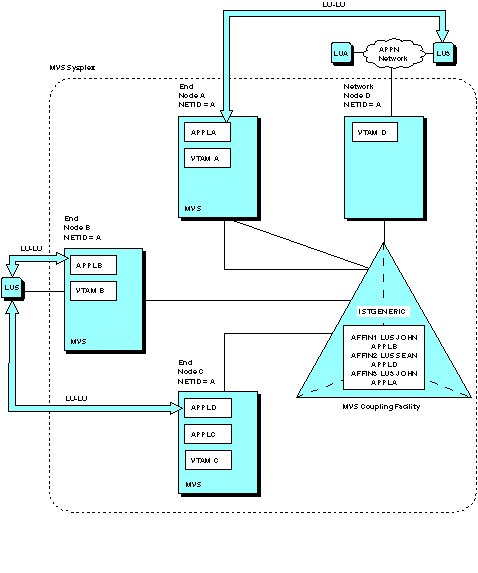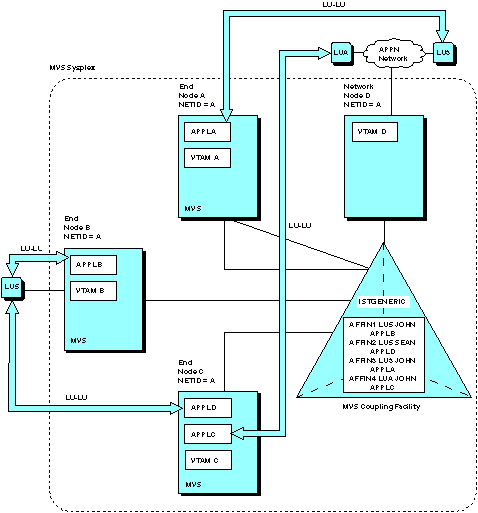 z/OS Communications Server: SNA Network Implementation Guide
z/OS Communications Server: SNA Network Implementation Guide
 z/OS Communications Server: SNA Network Implementation Guide
z/OS Communications Server: SNA Network Implementation Guide
|
Previous topic |
Next topic |
Contents |
Contact z/OS |
Library |
PDF
Partner LU mapping z/OS Communications Server: SNA Network Implementation Guide SC27-3672-01 |
|
|
The generic resource structure also contains a mapping that identifies the partner LUs for each generic resource member. When the first session is established between an LU and a generic resource member, VTAM® creates a mapping for that LU. This mapping, or affinity, identifies the name of the LU, the application program network name of the generic resource member, and the generic resource name. When subsequent parallel sessions are established using the same generic resource name, VTAM uses this mapping to ensure the session is established with the same generic resource member. Figure 1 shows partner LU mapping information. In this example, LU5 is in session with APPLB using the generic resource name JOHN and is in session with APPLD using the generic resource name SEAN. LU3 is in session with APPLA using the name JOHN. Figure 1. Partner LU mapping
 When LUA initiates a session with JOHN, VTAM determines whether LUA has an affinity with a generic resource member for JOHN. Because LUA does not have an affinity with any generic resource member using the name JOHN, VTAM establishes the session with the generic resource member having the least number of LU-LU sessions (in this example, APPLC). Figure 2 shows the affinity that is created after LUA establishes a session with JOHN. VTAM resolves the session to APPLC; LUA is only aware of having established a session with JOHN. All subsequent parallel sessions between LUA and JOHN resolve to the same generic resource member, APPLC, regardless of session count. Figure 2. Session establishment with generic resource
members
 Affinities are deleted by their owner. Unless overridden by LUAFFIN=NOTAPPL specified for OPNDST, OPNSEC, or APPCCMD (CNOS, PREALLOC, or ALLOC) when a session is established, the application owns all affinities for sessions using:
The application program is also owner of all affinities when AFFIN=APPL is specified for the SETLOGON OPTCD=GNAMEADD issued by the application, provided this is not overridden by LUAFFIN=NOTAPPL specified for OPNDST, OPNSEC, or APPCCMD (CNOS, PREALLOC, or ALLOC) when a session is established. The application program owns the affinity because of a particular session when LUAFFIN=APPL is specified for OPNDST, OPNSEC, or APPCCMD (CNOS, PREALLOC, or ALLOC) when a session is established. The application program can delete an affinity by using the CHANGE OPTCD=ENDAFFIN macroinstruction, after all sessions between the application and the LU have terminated. The application program can assign the affinity ownership to VTAM, even if there are still sessions with the LU, by issuing the CHANGE OPTCD=ENDAFFNF macroinstruction. VTAM will delete VTAM owned affinities when the last session between the LU and the application has terminated. LU 6.2 sessions, whose affinities are not owned by the application, are retained for 10 minutes after the last session, or for some other user-specified period (specified by start option AFFDELAY). For further information, see z/OS Communications Server: SNA Programming. 


|
 Copyright IBM Corporation 1990, 2014 Copyright IBM Corporation 1990, 2014 |